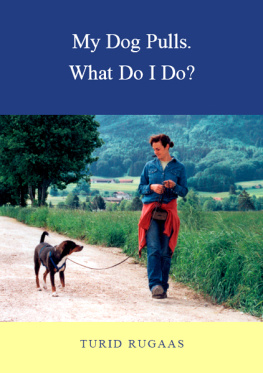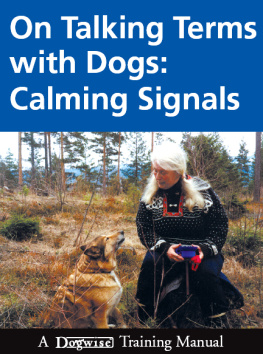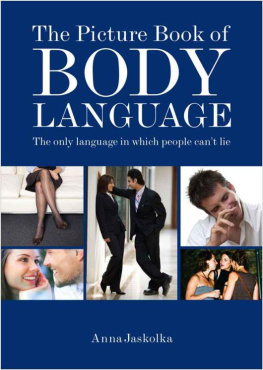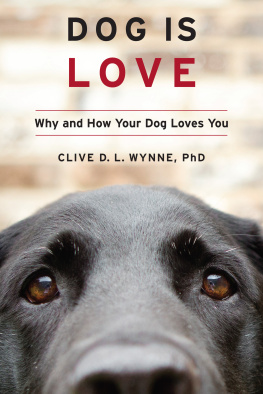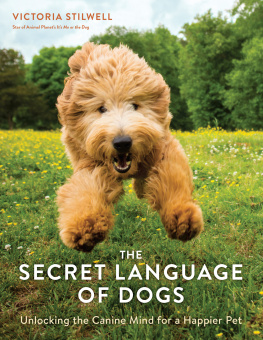
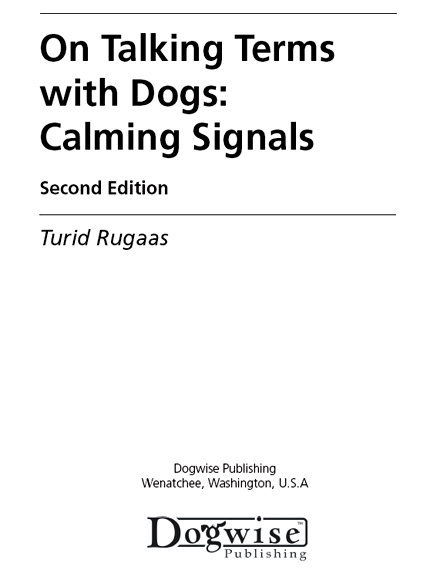
On Talking Terms With Dogs: Calming Signals, 2nd edition.
Turid Rugaas
Dogwise Publishing
A Division of Direct Book Service, Inc.
403 South Mission Street, Wenatchee, WA 98801
www.dogwisepublishing.com
Turid Rugaas, 1997, 2006
Originally published in Norway under the tilte
P Talefot Med Hunden, De Dempende Signalene
UK Editor Sheila Harper
Photographs by Turid Rugaas, Diana Robinson, Hilde Malm, Kirsten Berger, Gerd Groenwald, Gerd Khler, Sheila Harper, Nicole Frhlich, Sophie Hensley, Winkie Spiers and Cordelia Derrfu
All rights reserved. No part of this publication may be reproduced or transmitted in any form or by any means, electronic, digital or mechanical, including photocopying, recording or by any information storage or retrieval system without written permission from the publisher.
Limits of Liability and Disclaimer of Warranty:
The author and publisher shall not be liable in the event of incidental or consequential damages in connection with, or arising out of, the furnishing, performance, or use of the instructions and suggestions contained in this book.
Cataloging-in-Publication Data is available upon request from the Library of Congress
ISBN: 978-1-929242-36-8
Printed in the USA
Contents

My everlasting gratitude and love to VESLA
who started it all, just by being herself
This book was written thanks to Terry Ryan, who nagged me into
doing it, helped me with art work for it, and had the first edition
published. Thanks Terry!
The big Briard attacked violently and with a roar. He went for the little Elkhound at full speed. She stopped moving, stood quite still, and turned her head to one side. Just a few feet away from the Elkhound, the Briard stopped and looked bewildered as if he didnt know what to do. Then he started to look around for some replacement activity, sniffed a little at the ground, and turned to head back to base.
The place was my training field. The client was a Briard with dog-to-dog problems. The little Elkhound was my own Vesla, who was thirteen years of age.
Vesla always knows what to do and she always manages to calm down other dogs, whether they are aggressive, afraid, stressed or just being a nuisance. For eleven years no dog has been able to throw her off her mental balance. She is the image of a survivor, a conflict-solving dog with all the communication skills needed to survive.
Vesla wasn't always like that. She came to me as a stray dog. We meant to re-home her as she upset my own dogs with her aggressive and violent behavior. She fought, she quarrelled, she was stressed and she was impossible, and I didn't feel the right inclination to start to work with her. But nobody else wanted her, so with a sigh of resignation we kept her and started to try to incorporate her into our family of people and dogs.
It was a time of trials. I am sure she was the worst dog I have ever had in the house. Gradually, though, things got better. She stopped climbing the curtains. She could go for walks without trying to bite the others all the time. She could relax now and again.
And then one day I saw to my astonishment that she had actually started to communicate with the other dogs. Their work had started to get through to her! When I discovered that she actually was recovering her dog language, I tried my usual method for training. I praised every step in the right direction, and every time I caught a glimpse of a calming signal, I praised her. She became better and better at communicating. I realized to my surprise that it was possible to reinforce her own language by praising her, and then things happened very quickly. She was now helped by both my dogs and myself. In a very short time she was a miracle of dog language. One year after I got her, she had stopped all her aggressive behavior, and from then until today, twelve years later, she has not once been in trouble with any dog. They just cannot make her lose control.
The story of Vesla made me realize that it is possible to re-teach lost language to dogs. Since then I have made this teaching a life-style and my main job. And it has enriched my life: I now understand better and see better what dogs feel. I truly feel that I am on talking terms with the dogs. And that gives me a good feeling, just like the childhood dream about talking to animals.
Thank you Vesla, for all you taught me. It changed my life.
Authors note: This was written in 1996. Vesla died a few years later.
The social dynamics of a wolf pack is often used as a model for dog-dog and dog-human interactions. I have seen dog people (and some wolf people as well) caught up in the idea of always maintaining high rank by aggressive means, believing their only choices are between forcibly dominating the animal or submitting to it. The problem with this approach is two-fold. Firstly, aggression may well escalate, and secondly, an either-or choice between forcible dominance or submission is not the only choice available to wolves, to dogs or to humans.
With what she calls calming signals based on canine expressive behavior, Turid Rugaas introduces dog trainers and owners to another option to try to improve relationships between humans and their dogs and between dogs and other dogs. Pat Goodman
Foreword
The occasion was Animals and Us, the Sixth International Conference on Human-Animal Interactions in Montreal. A quiet, polite seminar attendee, Turid Rugaas, sat a couple of rows ahead of me during the canine behavior sessions. Turid should never play poker. I couldnt help but notice her shoulders tensing up or relaxing depending on the speaker. The funny thing was, her body language was directly reflecting my own opinion of the various speakers presentations.
Networking! Thats what symposiums are all about! I wanted to meet this stranger from overseas whose response to behavior issues seemed to so closely mirror my own. Realizing that English was not her native tongue, and wondering if she would understand, it took me until the end of the day to gather the nerve to approach her. Since that meeting back in 1992, I have spent a lot of time with Turid. Ive invited her to present at my behavior and training camps and seminars both in the United States and overseas. She has captivated her audiences wherever she goes. She was a big hit in Japan with her blue eyes and flaxen braids!
Turids farm, Hagan Hundeskole, is located on a heavily forested mountain top overlooking scenic fiords of Norway. People from all over the country bring their dogs for her instruction in basic manners and rehabilitation of problem behaviors. I have been there to observe during her work with dogs and she has amazed me. The stories she tells in this book are true. I have come to realize that she is on the cutting edge of understanding canine behavior. The following quote from Turid gives the essence of her theory on calming-signals.
Dogs, being flock animals, have a language for communication with each other. Canine language in general consists of a large variety of signals using body, face, ears, tail, sounds, movement, and expression. The dogs innate ability to signal is easily lost or reinforced through lifes experience. If we study the signals dogs use with each other and use them ourselves, we increase our ability to communicate with our dogs. Most noteworthy of all canine signals are the calming signals, which are used to maintain a healthy social hierarchy and resolution of conflict within the flock. These are skills which, when carried over to our own interactions with dogs, can be highly beneficial to our relationship. Dogs have the ability to calm themselves in the face of a shock (fearful or stressful situation) and to calm each other as well. As an example lets consider the manner in which dogs meet each other. Dogs which are worried in a social situation can communicate concepts such as, I know you are the boss around here and I won't make trouble. Furthermore, the boss dog is very apt to want the worried dog to realize that no trouble is intended. Dont worry, Im in charge around here and I mean you no harm. Dogs that do not signal properly can be the cause of problems.
Next page


